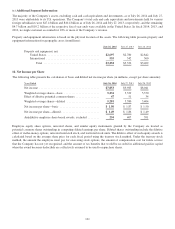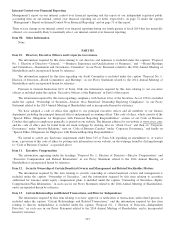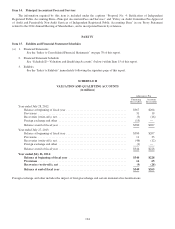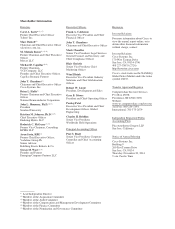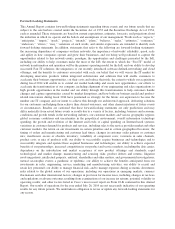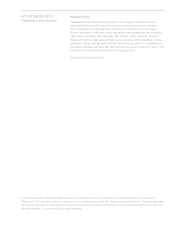Cisco 2014 Annual Report Download - page 138
Download and view the complete annual report
Please find page 138 of the 2014 Cisco annual report below. You can navigate through the pages in the report by either clicking on the pages listed below, or by using the keyword search tool below to find specific information within the annual report.Forward-Looking Statements
This Annual Report contains forward-looking statements regarding future events and our future results that are
subject to the safe harbors created under the Securities Act of 1933 and the Securities Exchange Act of 1934,
each as amended. These statements are based on current expectations, estimates, forecasts, and projections about
the industries in which we operate and the beliefs and assumptions of our management. Words such as “expects,”
“anticipates,” “targets,” “goals,” “projects,” “intends,” “plans,” “believes,” “seeks,” “estimates,” “continues,”
“endeavors,” “strives,” “may,” variations of such words, and similar expressions are intended to identify such
forward-looking statements. In addition, statements that refer to the following are forward-looking statements:
the increasing dependence of companies on their networks, the importance of networks’ reliability, speed, scale
and agility in how companies operate and grow their businesses, and our being well positioned to capture the
opportunities related to this network-centric paradigm; the opportunities and challenges presented by the IoE,
including our ability to help customers make the most of the IoE; the extent to which the “Fast IT” model of
network transformation and operation will be the primary operating model for the IoE, and our ability to develop
successful Fast IT solutions; the uniqueness of our recently introduced software-defined-networking and cloud
offerings, and the benefits to customers associated with each; our belief that we will win in the IT market by
developing innovative products within integrated architectures and solutions that will enable customers to
accelerate their business opportunities, cut their costs and reduce their risk; the extent to which our acquisitions
during fiscal 2014 will enable us to extend our market leadership and create new opportunities; our efforts to
accelerate the transformation of our company, including alignment of our engineering and sales organizations to
high growth opportunities in the market and our ability through this transformation to help customers handle
changes and capture opportunities caused by market disruptions, and how both our business model and product-
related innovations during fiscal 2014 have positioned us strongly for the future; our aspiration to become the
number one IT company and our intent to achieve this through our architectural approach, delivering solutions
for our customers and helping them achieve their desired outcomes; and other characterizations of future events
or circumstances. Readers are cautioned that these forward-looking statements are only predictions and may
differ materially from actual future events or results due to a variety of factors, including: business and economic
conditions and growth trends in the networking industry, our customer markets and various geographic regions;
global economic conditions and uncertainties in the geopolitical environment; overall information technology
spending; the growth and evolution of the Internet and levels of capital spending on Internet-based systems;
variations in customer demand for products and services, including sales to the service provider market and other
customer markets; the return on our investments in certain priorities and in certain geographical locations; the
timing of orders and manufacturing and customer lead times; changes in customer order patterns or customer
mix; insufficient, excess or obsolete inventory; variability of component costs; variations in sales channels,
product costs or mix of products sold; our ability to successfully acquire businesses and technologies and to
successfully integrate and operate these acquired businesses and technologies; our ability to achieve expected
benefits of our partnerships; increased competition in our product and service markets, including the data center;
dependence on the introduction and market acceptance of new product offerings and standards; rapid
technological and market change; manufacturing and sourcing risks; product defects and returns; litigation
involving patents, intellectual property, antitrust, shareholder and other matters, and governmental investigations;
natural catastrophic events; a pandemic or epidemic; our ability to achieve the benefits anticipated from our
investments in sales, engineering, service, marketing and manufacturing activities; our ability to recruit and
retain key personnel; our ability to manage financial risk, and to manage expenses during economic downturns;
risks related to the global nature of our operations, including our operations in emerging markets; currency
fluctuations and other international factors; changes in provision for income taxes, including changes in tax laws
and regulations or adverse outcomes resulting from examinations of our income tax returns; potential volatility in
operating results; and other factors listed in Cisco’s most recent report on Form 10-K contained in this Annual
Report. Our results of operations for the year ended July 26, 2014 are not necessarily indicative of our operating
results for any future periods. We undertake no obligation to revise or update any forward-looking statements for
any reason.



